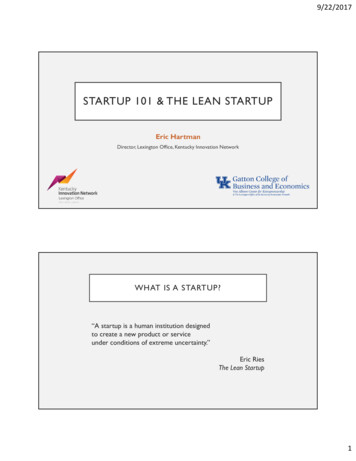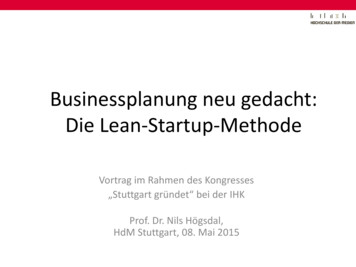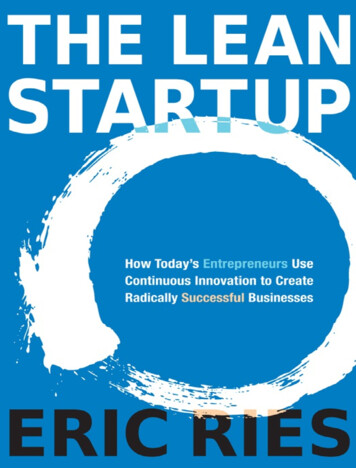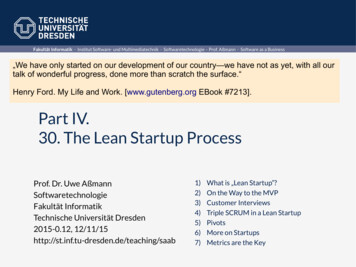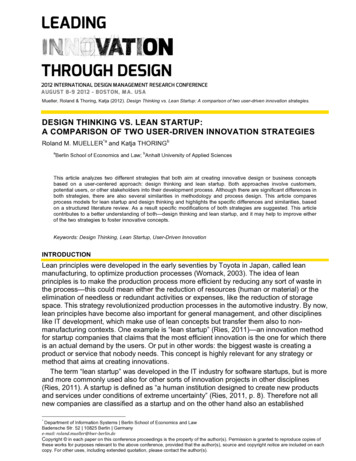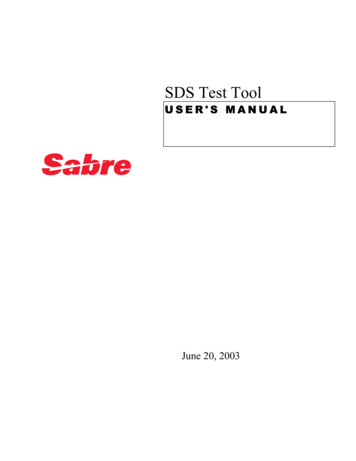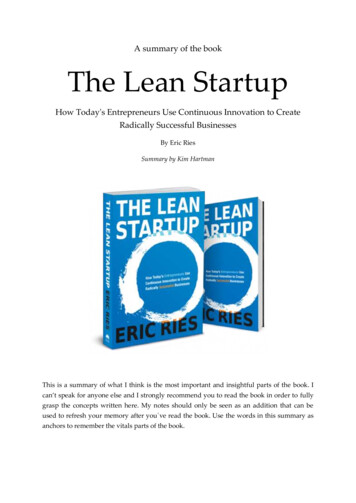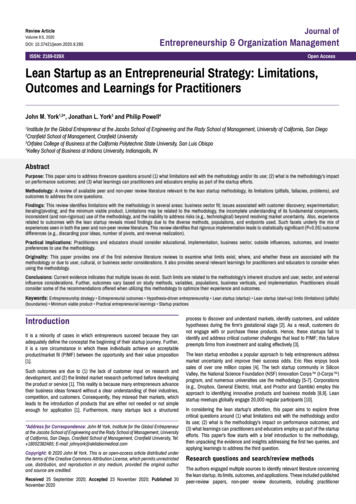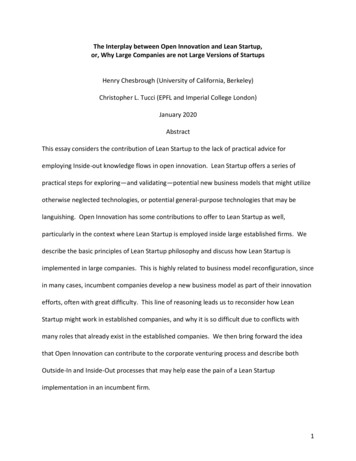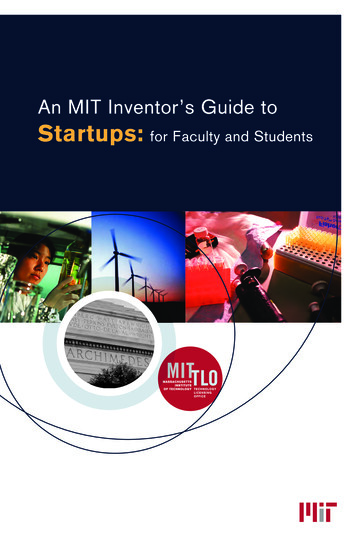
Transcription
TABLE OF CONTENTSOverview .2Startup Launch .4The MIT Entrepreneurial Ecosystem .6Technology Licensing Office.7Deshpande Center for Technological Innovation .8Venture Mentoring Service .9Entrepreneurship Center .10 100K Entrepreneurship Competition .11Enterprise Forum .11Student Clubs .12Lemelson-MIT Program .13Technology Showcases/Events .14Getting Started With the TLO .15Startup Licensing .17MIT Intellectual Property Policy .19Conflicts of Interest or Commitment: Faculty .21Resources for the Entrepreneur .24The MIT Inventor’s Guide to Startups is intended as a quick reference tool for MITfaculty, students and staff inventors interested in starting a company based on their inventions.Where can you go for help? This guide summarizes the many resources available to MIT inventorsand the institutional policies that are most relevant to startups. We also answer questions thatMIT entrepreneurs frequently ask our Technology Licensing Officers.For more information, visit web.mit.edu/tlo/www or call the MIT Technology Licensing Officeat 617-253-6966. Official MIT policies are contained in MIT’s Policies and Procedures, available athttp://web.mit.edu/policies/ and in the “Guide to the Ownership, Distribution and CommercialDevelopment of MIT Technology” accessible via the TLO website. The contents of this brochureare not intended to replace or supercede these policies.
OVERVIEWA startup is a new business venture inits earliest stage of development.This guide to startups is focusedspecifically on technology-basedcompanies formed to commercializeone or more related inventions madeat MIT and protected via intellectualproperty rights (i.e. patent orcopyright) owned by MIT.Brontes, E Ink, Ember, LuminusDevices, Momenta Pharmaceuticals,OmniGuide, QD Vision, Xtalic andZ Corporation.If you’re contemplating your ownstartup, you probably already knowthat entrepreneurship knowledge isa rich lode that runs throughout theInstitute. Tapping it is a matter ofknowing where to look. Within theMIT community, you can find manyof the answers to your questionsabout how to launch a business basedon MIT intellectual property andconnections to the many people whocan help you do so. MIT entrepreneurs have started abouttwenty companies a year over the lastten years based on licenses to MITtechnology. While not every startupsucceeds, the track record has beenimpressive and includes companieslike A123, Akamai, Alnylam,NUMBER OF COMPANIES 1710502001200220032006 2007Fiscal YearPAGE 2200820092010
“Ideas and innovations flow steadily from MIT into the marketplace.With the startup companies they launch and nurture, our faculty,students and alumni transform great innovations into a vital forcefor economic growth. Through the drive and ingenuity of MITentrepreneurs—and the ecosystem the Institute offers to helpthem thrive—startups constitute a powerful way that MIT servesthe region, the nation and the world.”SUSAN HOCKFIELDPRESIDENT, MASSACHUSETTS INSTITUTE OF TECHNOLOGYPAGE 3
STARTUP LAUNCHWhile every MIT startup follows itsown unique path, the major steps toget the business off the ground aresummarized on the facing page.How long does it take?The time it takes to complete thesteps in the startup process variesgreatly among inventors and oftendepends on many aspects of the business coming together simultaneously,such as the participants’ ability toengage in the business, the ripeningof the technology and the momentum that may be achieved fromentering a business plan competitionor forging a strategic connection.Nonetheless, we can provide a fewballpark figures. Typically a patent application takes a few weeks toprepare and file, including the time ittakes inventors to review and revise apreliminary draft of the application.Negotiation of a license agreementwith the TLO can take anywherefrom a few weeks to a few months.Many inventors spend months, andsometimes years, tapping into theMIT Entrepreneurial Ecosystemwhile taking care of the other stepsin the startup process—and pursuingtheir academic research and educationresponsibilities. Time spent immersedPAGE 4in this ecosystem may shorten thetime it takes to attract funding, bystreamlining connections and focusing your efforts. But a fair estimatefor the time it takes to attract andclose a first round of funding wouldbe several months at a minimum.How much can I tell people aboutmy technology?Once your invention is protectedby a patent application, it’s safe todiscuss it both inside and outsidethe MIT community. If you want todiscuss your invention with others(outside of MIT) before a patentapplication has been filed you shouldhave the person (or company) sign aconfidentiality agreement (or “NonDisclosure Agreement”), agreeing tokeep your invention in confidence,before you have the discussion.The TLO can help you with theNDA if the confidential informationis related to your research at MIT.
STEPS TO STARTUP LAUNCH1TALK TO THE TLO: We encourage you to contact the Technology Licensing Officeearly in the process to discuss your invention, how to protect the intellectual property,and your thoughts about a startup company.2PROTECT INTELLECTUAL PROPERTY: In a startup, a major source ofvalue, and thus a major tool for attracting investment, is intellectual property (usuallyone or more patents or substantial software code). Engage with the patent attorneycontracted by the TLO to get a patent application filed on your invention before youmake any public disclosure or communication of it, since early disclosure may limityour ability to get a patent, particularly outside the U.S.3SEEK INPUT AND NETWORK: MIT provides a wealth of resources forinventors looking for help starting a company. The MIT Entrepreneurial Ecosystem,as summarized in the pages that follow, can shepherd MIT inventors through allfacets of the startup process—from writing a business plan, to meeting like-mindedentrepreneurs and investors, to attracting board members, to securing funding todemonstrate an invention’s commercial viability.4PLAN THE BUSINESS: A formal business plan may or may not be part of thisphase, but you’ll need to develop an understanding of market potential, competition,funding needs, and how you plan to develop the product and attain the revenuessufficient to sustain and grow the company.5NEGOTIATE THE LICENSE OR OPTION AGREEMENT: The TLOwill negotiate with a representative of the company to grant a license to the startup.In some cases, a short-term option agreement may precede a license so yourcompany can demonstrate to potential funders that it has secured the rights tonegotiate for a license to the technology.6PURSUE FUNDING: Commercializing technology is typically a capital-intensiveprocess. You’ll need to present your opportunity to people with the funds to help youmake it happen: venture capitalists, angel investors and perhaps in the initial stages,friends and family. Participation in the MIT Entrepreneurial Ecosystem is one way tostart the personal introduction process that can help you get the attention of angel andventure capital investors.PAGE 5
THE MIT ENTREPRENEURIALECOSYSTEMOver the years, MIT has seen thegrowth of dozens of organizations,programs, centers, courses and awardsthat foster the entrepreneurial spiriton campus. These help turn what isinherently a disorderly process into amanageable pathway for inventors.As you move through the overlappingparts of the ecosystem, taking steps toguide your invention toward marketreadiness, you will interact with anentire community interested in supporting, learning about, and investingin technology entrepreneurship.That community can not only enrichand inform your startup, raising questions that you may not have evenconsidered, but boost your enthusiasm for the endeavor by introducingyou to fellow entrepreneurs.On the pages that follow are briefdescriptions of some of the majorcomponents of this entrepreneurialecosystem. Additional informationon each of them can be found ontheir websites or by contactingthem directly.“Starting a company is about creating something new that willin some way, large or small, change the world by opening newmarkets and addressing unmet human needs. That’s the joy andsatisfaction of it. And you couldn’t ask for a better springboardthan MIT, where the rich entrepreneurial ecosystem will help atevery step of the journey.”RAY STATA ’57CHAIRMAN AND CO-FOUNDER, ANALOG DEVICES INC.PAGE 6
The longstanding mission of the Technology Licensing Office is to enable theinventions and discoveries made at MIT to find further development in thecommercial world so that the public will ultimately benefit from the breakthroughs that arise from research at the Institute. The TLO achieves this goalby patenting MIT inventions, copyrighting software and then licensing thatintellectual property to companies both large and nascent.TLO Licensing Officers, who cover particular technology areas, are available asa resource to all MIT faculty and student inventors who would like to discusstheir inventions, their business ideas or any questions about the startup process.Officers can advise on: any obligations to sponsors for a particular invention the ownership of a particular invention conflict of interest issues and MIT’s policies and guidelines related to themAt the crossroads between MIT and members of the business, entrepreneurialand venture communities, the TLO also maintains constant communicationwith people who can and have made startups happen. Officers can provideguidance and insights on: the potential viability of a business model potential investors, entrepreneurs other sources of help at MITFor more detailed information on the TLO’s activities, see pages 15 through 18 in thisbooklet and http://web.mit.edu/tlo/www/PAGE 7
The Deshpande Center and its grants and activities are focused on increasing the impact of MIT technologies in the marketplace by bridging the dividebetween idea and implementation. The Center provides grants to MIT facultyand principal investigators for research to be done in MIT laboratories.Any technological innovation that addresses a market opportunity may beeligible for these grants, though the emphasis is on technologies suitable forstartups. The grants come in the form of Ignition Grants (up to 50,000)intended to support promising exploratory or proof-of-concept projectsand Innovation Grants, which are typically larger grants (up to 250,000)intended to help a research project progress from an early stage to the pointwhere it is ready to attract venture funding or commercial investment.Deshpande Center grant recipients receive more than just money.Volunteers from the business community, known as Catalysts, provideguidance to recipients to help their innovations have an impact in themarketplace. In addition, Deshpande innovations may be the focus of i-Teamsof business and technology-savvy students who design go-to-market strategiesfor the technologies. Throughout the year, the Deshpande Center also hostsevents and programs, like their high-profile IdeaStream Symposium, thatfoster entrepreneurship and build connections among innovators and thefunding and business communities.For more information: http://web.mit.edu/deshpandecenter/PAGE 8
MIT stands at the heart of a rich community of successful entrepreneurs andbusiness people. The Venture Mentoring Service taps into this knowledgeresource, supporting innovation and entrepreneurial activity throughout theMIT community by matching prospective entrepreneurs with volunteer mentors who can boost the probability of a startup’s success. Budding entrepreneurs who apply to be VMS mentees are assigned to a team of 3 or 4 mentorswho provide practical, day-to-day professional advice and coaching. The mentoring service is open to MIT faculty, students, alumni and staff and licenseesof MIT technology, who reside in the Boston area.For more information: http://web.mit.edu/vms/PAGE 9
The Entrepreneurship Center’s mission is to educate, inspire and coach newgenerations of entrepreneurs. The Center offers courses on all aspects ofbusiness and entrepreneurship that are open to MIT students. (Many of thecourses are also open to others via the Center’s executive education program.)Some of the most popular student courses include: Innovation Teams (i-Teams) in which students develop commercializationstrategies for technology breakthroughs, most of which stem from currentDeshpande Center projects. Entrepreneurship Lab (E-Lab) in which students work one day a weekin a startup company. Global Entrepreneurship Lab (G-Lab) in which students work on a4-month, mini consulting project for international, entrepreneurial firms.The E-Center also hosts networking events throughout the year to bringtogether its extensive network of CEOs, alumni, students, faculty andventure capitalists.For more information: http://entrepreneurship.mit.edu/PAGE 10
The 100K Entrepreneurship Competition is a series of events that culminate in the Spring Business Plan Contest. Each event, including theElevator Pitch and Executive Summary Contests, focuses on a differentaspect of the entrepreneurial experience, and builds toward the final competition in which polished and mentored business plans are judged by panels ofexperienced entrepreneurs, venture capitalists and legal professionals. In themore than 20 years that the Business Plan Competition has been active, it hasfacilitated the birth of over 120 companies.Teams for the Business Plan and Executive Summary contests must containat least one currently registered MIT student. Many also include MIT facultymembers and students from multiple departments at MIT as well as other universities and business schools.For more information: http://www.mit100k.org/For over 30 years, the Enterprise Forum has been offering networking andeducational programs about technology entrepreneurship. These activities areoffered via the Forum’s many regional chapters, such as the MIT EnterpriseForum of Cambridge. That chapter’s programs include monthly, local Startupand Concept Clinics, which feature presentations on efforts to bring earlystage technologies to market. Enterprise Forum programs are open to anyoneinterested or involved in technology entrepreneurship.For more information: umcambridge.org/PAGE 11
Student ClubsMIT boasts a number of student-run, business and professional clubs that provide educational and networking opportunities for all members of the MITcommunity. These include: Entrepreneurs Club (EClub) (http://web.mit.edu/e-club/), open toMIT and Harvard students, faculty, staff, alumni and select professionals.The EClub hosts weekly club meetings and periodic networking andeducational events, including the annual IAP class: The Nuts and Bolts ofBusiness Plans. Innovation Club (iClub) (http://iclub.mit.edu/), open to all individualsaffiliated with MIT who are interested in innovating and learning how toapply new technologies in a business setting. The iClub hosts interactiveprograms such as Tech Testbeds, IdeaExchange brainstorms, InnovationLabs and a Discussion Series. Science and Engineering Business Club (SEBC)(http://web.mit.edu/sebc/), open to MIT students and post-doctoral fellows, with programs that extend to all members of the MIT community.With VCPE (see below), the club co-hosts Venture Ships, in which teams ofstudents work with MIT-affiliated early-stage companies on current business issues, helping them gain valuable entrepreneurial skills. The club alsohosts a Fall Networking BBQ and other events that support its mission ofproviding its members with opportunities for networking and receivingmentorship in the fields of consulting, finance, marketing or technologyentrepreneurship. Venture Capital and Private Equity Club (VCPE)(http://www.mitvcpe.com/), open to MIT students and post-doctoral fellows, with programs that extend to all members of the MIT community.The club is focused on helping students learn about and develop contactswithin the venture capital and private equity industries. It runs or co-hostsnumerous workshops, lectures and events throughout the year, including an annual Venture Capital Conference on high-tech startup financingthat attracts hundreds of attendees each December. Speakers, panelists andinvited guests at the conference include dozens of venture capitalists andentrepreneurs from startups.PAGE 12
Lemelson-MIT ProgramThe Lemelson-MIT Program offers a collection of awards focused on recognizing and supporting inventors and innovation. It awards a 30,000 prizeannually to an MIT senior or graduate student who shows promise as aninventor. In addition, it awards a 500,000 prize annually to an outstandingmid-career inventor who has made a significant contribution to society. And its 100,000 Award for Sustainability recognizes inventors working to safeguardthe well-being of our communities and planet.The Program also runs outreach activities, like their EurekaFest celebration,and offers educational materials for inventors interested in boosting the societaland commercial impact of their innovations.For more information: http://web.mit.edu/invent/PAGEPAGE1313
Technology Showcases/EventsTechnology Showcases are usually industry-specific events in which entrepreneurs can pitch their startup ideas and technologies to potential investors. Several such showcases are hosted each year by non-profit entities likethe Massachusetts Technology Transfer Center (MTTC), the MassachusettsClean Energy Center (MassCEC), the Massachusetts Biotechnology Council(MassBio) and The Capital Network (TCN). In addition, the Mass TechnologyLeadership Council (MassTLC) hosts a series of unConferences where smallgroups gather to discuss ad hoc topics in innovation, providing excellentopportunities for entrepreneurs to meet people who can help them build theircompanies. These events and institutions are part of the broader, state-wideecosystem for supporting entrepreneurial activity and can be a rich source foreducation and networking. For more information:MTTC: http://www.mattcenter.org/MassCEC: http://www.masscec.com/MassBio: http://www.massbio.org/TCN: http://www.thecapitalnetwork.org/MassTLC: http://www.masstlc.org/PAGE 14
GETTING STARTEDWITH THE TLODisclose the InventionBy filling out the TLO’s TechnologyDisclosure Form you provide TLOstaff members with the informationthey need to determine the ownership of the invention, to sort out anyobligations MIT may have to sponsors of the research that led to theinvention and to ascertain what sortof intellectual property protection(e.g. patent or copyright) is warrantedso that you can pursue commercialization of the technology.The Technology Disclosure is treatedas a confidential document by TLOstaff members and you should fullydescribe your invention in it. It isbest to submit the Disclosure Formwell before any publication or publiccommunication of the invention,including website descriptions, lectures, posters or abstracts.You can download a technology disclosure form and simple instructionsat: http://web.mit.edu/tlo/www/misc/forms.htmlTalk to a Licensing OfficerTLO staff members can help youmake the decision on whether youwould like to start a company or justhave the TLO out-license the technology.Your plans for a business, andhow fully fleshed-out the inventionis, will feed into decisions about howand when to protect the intellectualproperty. Any intellectual propertyobligations to research sponsors mustalso be considered.Your TechnologyLicensing Officer can provide guidance on next steps, sources of additional information, and potentiallyuseful contacts.A more detailed summary of theTechnology Transfer process can befound in the Inventor’s Guide to TechTransfer available at: ork with the AssignedPatent AttorneyOnce a decision is made to patent aninvention, the TLO hires an outsideattorney to prepare and file a patentapplication.You’ll need to ‘teach’ theattorney about your novel invention,but the attorney will do most of thework in generating a patent application.You should also inform theattorney about your business plans sothat the most appropriate claims canbe drafted.PAGE 15
Software may or may not containpatentable subject matter and thedecision on whether to patent suchsubject matter will depend in part onthe plan for commercialization.In many cases, before filing a patentapplication, your Licensing Officermay ask you to sit with a researchlibrarian specially trained in patentand literature searches to look for“prior art” (anything related to theinvention and its originality that hasalready been publicly disclosed orused). Prior art searching is important to determining the potentialbreadth of a patent and what sorts ofbusiness uses it may cover.If you’re contemplating a startup it’simportant to understand the distinction between prior art searching,which falls within the TLO’s scopeof activities, and “freedom to operate” searching, which neither theTLO nor its research librarian perform on behalf of companies.A freedom to operate search looksfor any other patents or applicationsthat may block your company’s ability to make or sell its products orservices without permission (i.e. alicense) from the patent holder. Notethat a patent allows its holder (or insome cases, its licensee) to bar othersfrom operating in a particular area,but does not guarantee the holder orlicensee the right to practice in thatarea, since the resulting product orservice may still fall under another,broader “blocking” patent. At somepoint during their development,most startups need to do their ownfreedom to operate analysis. “MIT’s TLO staff members offer the community a unique blend ofintimate knowledge of the value of the innovations developed inlabs on campus partnered with expert and enthusiastic guidancethrough every phase of intellectual property and industry launchprocesses. The entrepreneurial networks that Cambridge boaststoday are surely due in no small part to the skilled efforts of theTLO in fostering connections between academia and industry inthe interest of maximizing real-world returns on the discoveries thathappen every day at MIT.”RAM SASISEKHARANDIRECTOR, HST AND EDWARD HOOD TAPLIN PROFESSOROF HEALTH SCIENCES & TECHNOLOGY AND BIOLOGICAL ENGINEERINGMASSACHUSETTS INSTITUTE OF TECHNOLOGYPAGE 16
STARTUP LICENSINGThe TLO’s main goals in any licenseagreement are to ensure that thetechnology will be developed bythe licensee for public benefit, complying with federal and MIT policies,and, if successful, providing a reasonable financial return to MIT andthe inventors of the technology.The terms of startup licenses are flexible and take into account the financial realities of many startups as wellas the particular industry in whichthe company will be competing.Standard requirements in a licensefor an MIT startup will includenegotiated financial terms, such asannual fees and a royalty on productsales, and reimbursement of patentcosts. They may also include asmall, minority share of equity inthe startup.The non-financial terms of thelicense are equally important andwill include: Degree of exclusivity: nonexclusive, exclusive, or restricted byfield of use Reservation of rights for theFederal government (if theinvention is derived fromFederally-funded research), andfor MIT and other non-profitorganizations for their researchand educational activities Performance (or “diligence”)requirements to assure that thecompany has the resources and iscapably developing the technologyIn many cases, the TLO will workwith startups to delay major financialpayments until the company raisessignificant investment capital.PAGE 17
Will MIT assign the patentto my startup?No, but an exclusive license, whichgives most of the rights to the patentthat an assignment would give, cansatisfy the needs of the company.Does MIT take a seat on thecompany board?No.Can I get a license if I haven’tincorporated the company yet?No, but an option agreement may bepossible. Such an agreement will, fora limited time, preserve the opportunity for your company to negotiate alicense.If my startup is based on an invention jointly owned by MIT and anotherinstitution, how do I get started?The TLO will work out an InterInstitutional Agreement whereby oneof the institutions will “take the lead”and do the license negotiations withyour company.If my startup needs technology fromanother institution besides MIT, but notjointly owned with MIT, will I need aseparate license?Under most circumstances you willneed to negotiate separately withthe other institution for a license.However schools do sometimes package their technologies together in asingle license agreement.PAGE 18Which comes first, the license agreementor the funding agreement?It generally works to the founders’advantage to get the license agreementdone first, but it can be done eitherway. Fees and reimbursement of patentcosts can be delayed pending funding.If my invention is unpatented software,do I still need a license for a startup?Yes, a copyright license is required ifthe software falls under MIT’s ownership policy.Can I continue to do researchon the technology on which mystartup is based?MIT always reserves the rightto practice its own inventions withinits facilities. The invention can beused in your research at MIT forresearch purposes only. Researchersare not permitted to continue todevelop technology at MIT for thebenefit of their startups. See theConflict of Interest section forfurther details.
MIT INTELLECTUAL PROPERTYPOLICYOwnership of InventionsGenerally speaking, under MIT’spolicy on intellectual property ownership, the Institute owns inventionsmade by its employees when thoseinventions are developed pursuantto a sponsored research agreementor created using significant funds orfacilities administered by MIT.The policy is stated in more detail in theGuide to the Ownership, Distributionand Commercial Development of MITTechnology, which can be located on theTLO website at: .1This ownership policy applies to anysort of intellectual property, including: patents, copyrights on software,maskworks, tangible research propertyand trademarks.If an invention is made by a student,the policy is the same as for anyother member of MIT. Ownershipdepends on 1) whether the invention was created by the student ina capacity as an MIT employee, 2)whether the invention was createdusing MIT resources, and (3) whetherthe invention was created under acontract or grant to MIT.MIT does not assert ownership ofan invention made while consulting for an outside company providedthat the invention was made withoutsignificant use of MIT funds or facilities. Particularly in a startup situationwhere an MIT faculty member isconsulting with a company foundedon one or more of his/her inventions,it is important to clearly delineate thedifferences between your responsibilities at the company and your researchat MIT, to minimize any conflict inownership of your inventions.If you have questions, the TechnologyLicensing Office is available for assistance. See contact information onpage 25.Obligations to SponsorsSponsored research agreementsspecify what rights a sponsor has inany intellectual property developed asa result of the sponsored research.Under most circumstances, Federalfunding of research leading to aninvention will not impose significantimpediments on commercializingPAGE 19
your invention via a startup.Funding by other entities (e.g. companies) may result in license rightsthat can limit the license rightsavailable for your startup. Corporatesponsors are typically granted rightsto negotiate a license for any intellectual property arising from sponsored research. But since sponsorshipagreements vary widely, check yoursponsored research agreement or withPAGE 20the TLO to become aware of anyrestrictions on your invention. For more details on the intellectual property rights granted in standard sponsorship agreements, see the MIT Office ofSponsored Programs’ Guide for IndustrySponsors of Research at MIT, available m
CONFLICTS OF INTEREST OR COMMITMENT:FACULTYConflicts of InterestAs the founder of a startup, you’relikely to receive equity in the company and may have a continuing consulting or advisory relationship withit. Therefore conflicts of interest canpotentially arise between your contractual or financial relationship withthe startup and your obligations toeducate and mentor students at MITand to perform research. An individual conflict of interest exists whenan individual (or his or her immediate family) has a financial interest thataffects or has the potential to affectthe individual’s conduct of his or herInstitute activities, because for example, he or she is the decision-makerrelated to research projects. Whenconflicts of interest arise they mustbe recognized, disclosed and eithereliminated or properly managed.MIT Policy dictates that your firstresponsibility is to the education ofyour students. It prohibits you fromusing MIT students for research anddevelopment projects fo
STEPS TO STARTUP LAUNCH SEEK INPUT AND NETWORK: MIT provides a wealth of resources for inventors looking for help starting a company. The MIT Entrepreneurial Ecosystem, as summarized in the pages that follow, can shepherd MIT inventors through all facets of the startup pro
